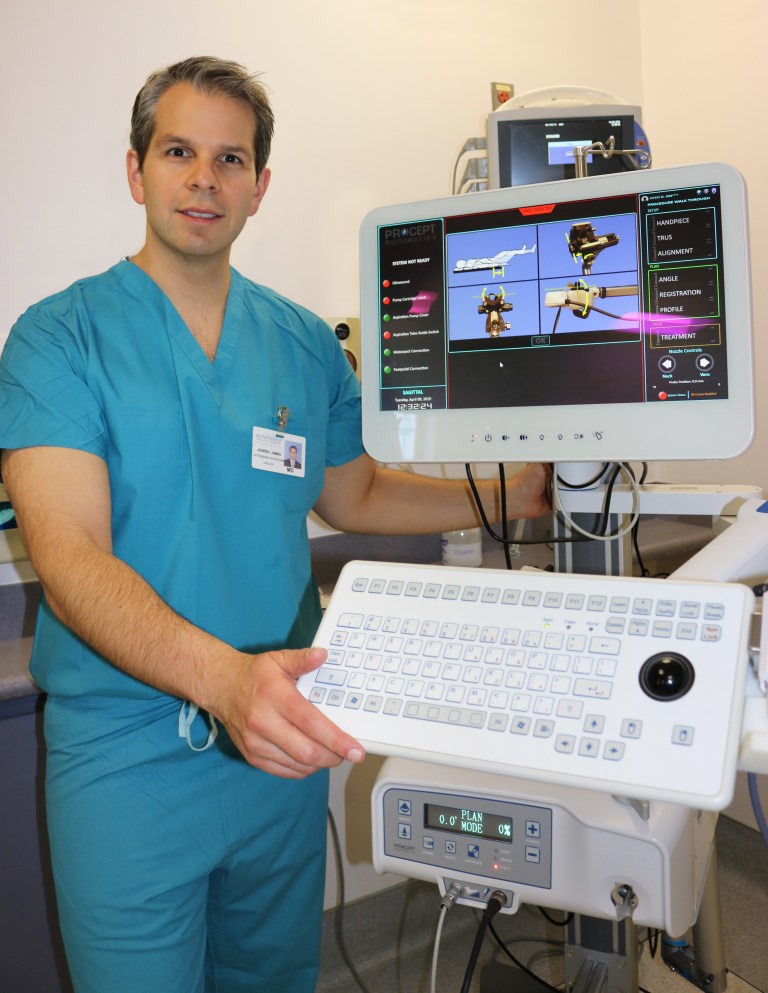
NYU Winthrop Hospital announced that it has successfully performed the first-ever Aquablation therapy in the New York/New England region. Aquablation is an advanced new therapy used to treat enlarged prostates, a common condition technically known as benign prostatic hyperplasia.
More than 50 percent of all U.S. men age 60 years and over suffer from enlarged prostates, as do more than 90 percent of men age 85 and over. An enlarged prostate is a noncancerous condition but one that produces symptoms, including frequent urination, an inability to empty the bladder, the need to urinate during the night, loss of bladder control, and more.
The delivery system for Aquablation is the first FDA-approved surgical robot providing autonomous tissue removal for treating BPH. The technology is unique in combining three key elements to remove tissue safely, quickly, and precisely: real-time, multidimensional imaging for improved decision-making and surgical planning; robotic execution for precision; and the power of a water jet — pulsating near the speed of sound — that is heat-free, thus avoiding thermal injuries that can occur with lasers. The therapy also has the significant advantages of conserving anatomical structures associated with urine control and sexual function, which is expected to drive extremely strong interest in the procedure.
“Aquablation offers an incredibly robust platform, allowing a level of control never before achieved in operations aimed at alleviating symptoms from enlarged prostates,” said Dr. Joseph Jamal, the robotic surgeon who pioneered the procedure at NYU Winthrop.
Jamal, who is the director of robotic urological operations at NYU Winthrop and a partner in Advanced Urology Centers of NY, is an expert in advanced surgical urology technologies, having performed over 1000 procedures using the da Vinci robotic platform.
Jamal noted that for decades, a procedure called Transurethral Resection of the Prostate has been the surgical gold standard for the treatment of BPH. In comparison, Aquablation therapy has demonstrated equivalent efficacy outcomes, an excellent safety profile, and a very significant reduction in sexual side effects. “I expect Aquablation to become the platinum standard for treating many cases of enlarged prostates,” he added.
Jamal likens harnessing the power of water jets to pressure cleaners, or high-pressure ultrasonic cleaners used by dentists to remove plaque. Except in the case of Aquablation, the high-velocity water jets are removing prostate tissue to decrease enlarged aspects of the prostate that are causing urinary issues.
The robust Aquablation platform involves utilizing a cystoscope, which is a thin tube with a camera that is used to view the urethra and inside of the bladder, under anesthesia. That technology is integrated with an ultrasound to provide a 3-D view of the prostate including height, width, length, and volume. This information, provided in real time via computer software, allows for the surgeon to determine an optimal tissue removal plan, including detecting healthy vs. unhealthy tissue and determining with exact precision the position of urethral sphincters (muscles that control urine flow) and ejaculation ducts critical to maintaining sexual function. Under this robotic procedure, water jets then sweep across the prostate, ablating bad tissue while avoiding the key anatomical structures. The cystoscope/ultrasound planning takes approximately 20 minutes, while the water-jet ablation can be completed in under five minutes.
“Aquablation offers a more holistic approach to treating men for enlarged prostates than traditional methods,” said Dr. Aaron Katz, chairman of the Department of Urology at NYU Winthrop Hospital. “In the past, men often had to choose between the lesser of two evils: relieve urinary problems but impact sexual function, or maintain sexual function but live with embarrassing and annoying urinary issues. Now, through this advanced procedure, resolving one side of the equation doesn’t have to negatively impact the other. This minimally invasive procedure also produces less scarring than traditional methods that rely on heated lasers to scrape away tissue and, in turn, less scarring reduces the need for secondary procedures.”
Katz noted that fast on the heels of Jamal’s success with the first procedure, numerous additional Aquablation procedures have been scheduled, and two other urology surgeons at NYU Winthrop recently received advanced training to also perform the procedure.






